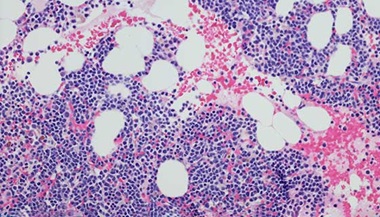Avascular Necrosis
What is avascular necrosis?
Avascular necrosis is a disease that results from the temporary or permanent loss of blood supply to the bone. When blood supply is cut off, the bone tissue dies and the bone collapses. If avascular necrosis happens near a joint, the joint surface may collapse.
This condition may happen in any bone. It most commonly happens in the ends of a long bone. It may affect one bone, several bones at one time, or different bones at different times.
Avascular Necrosis Q&A | Julius Oni, M.D.
What causes avascular necrosis?
Avascular necrosis may be the result of the following:
-
Injury
-
Fracture
-
Damage to blood vessels
-
Long-term use of medicines, such as corticosteroids
-
Excessive, long-term use of alcohol
-
Specific chronic medical conditions
What are the risk factors for avascular necrosis?
Risk factors include:
-
Injury
-
Steroid use
-
Caisson disease
-
Alcohol use
-
Blood disorders, such as sickle cell anemia
-
Radiation treatments
-
Chemotherapy
-
Decompression disease
-
Hypercoagulable state
-
Hyperlipidemia
-
Autoimmune disease
What are the symptoms of avascular necrosis?
The following are the most common symptoms of avascular necrosis. However, each person may experience symptoms differently. Symptoms may include:
-
Minimal early joint pain
-
Increased joint pain as bone and joint begin to collapse
-
Limited range of motion due to pain
The symptoms of avascular necrosis may look like other medical conditions or bone problems. Always talk with your healthcare provider for a diagnosis.
How is avascular necrosis diagnosed?
Along with a complete medical history and physical exam, you may have one or more of the following tests:
-
X-ray. This test uses invisible electromagnetic energy beams to make images of internal tissues, bones, and organs onto film.
-
Computed tomography scan (also called a CT or CAT scan). This is an imaging test that uses X-rays and a computer to make detailed images of the body. A CT scan shows details of the bones, muscles, fat, and organs. CT scans are more detailed than general X-rays.
-
Magnetic resonance imaging (MRI). This test uses large magnets, radiofrequencies, and a computer to make detailed images of organs and structures within the body.
-
Radionuclide bone scan. This nuclear imaging technique uses a very small amount of radioactive material, which is injected into the blood to be detected by a scanner. This test shows blood flow to the bone and cell activity within the bone.
-
Biopsy. A procedure in which tissue samples are removed (with a needle or during surgery) from the body for exam under a microscope. It’s done to find cancer or other abnormal cells or remove tissue from the affected bone.
-
Functional evaluation of bone. Tests that usually involve surgery to measure the pressure inside the bone.
How is avascular necrosis treated?
Specific treatment for avascular necrosis will be determined by your healthcare provider based on:
-
Your age, overall health, and medical history
-
Extent of the disease
-
Location and amount of bone affected
-
Underlying cause of the disease
-
Your tolerance for specific medicines, procedures, or therapies
-
Expectations for the course of the disease
-
Your opinion or preference
The goal of treatment is to improve functionality and stop further damage to the bone or joint. Treatments are needed to keep joints from breaking down, and may include:
-
Medicines. These are used to control pain.
-
Assistive devices. These are used to reduce weight on the bone or joint.
-
Core decompression. For this surgical procedure, the inner layer of bone is removed to reduce pressure, increase blood flow, and slow or stop bone and/or joint destruction.
-
Osteotomy. This procedure reshapes the bone and reduces stress on the affected area.
-
Bone graft. In this procedure, healthy bone is transplanted from another part of the body into the affected area.
-
Joint replacement. This surgical procedure removes and replaces an arthritic or damaged joint with an artificial joint. This may be considered only after other treatment options have failed to relieve from pain and/or disability.
Other treatments may include electrical stimulation and combination therapies to promote bone growth.
Key Points about Avascular Necrosis
-
Avascular necrosis is a disease that results from the temporary or permanent loss of blood supply to the bone. It happens most commonly in the ends of a long bone.
-
Avascular necrosis may be the result of injury, use of medicines, or alcohol.
-
Symptoms may include joint pain and limited range of motion.
-
Medicines, assistive devices or surgery may be used to improve functionality or to stop further damage to the affected bone or joint.




